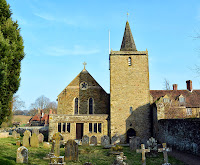Most church guides list the monuments to dead worthies last, but at Easebourne the tombs are virtually the only reason for visiting.
 The building itself is without interest, as almost every visible trace of the medieval building was swept away by the Victorians. Only its odd layout, with two naves and chancels side-by-side, recall the time when it was shared between the parish and the nunnery next door. The nuns had the south chancel and half of the south nave, a wall separating them from the gaze of the secular.
The building itself is without interest, as almost every visible trace of the medieval building was swept away by the Victorians. Only its odd layout, with two naves and chancels side-by-side, recall the time when it was shared between the parish and the nunnery next door. The nuns had the south chancel and half of the south nave, a wall separating them from the gaze of the secular.
It is the monuments to past owners of next-door Cowdray Park that make the place worthwhile.
Chronologically, the first is the recumbent figure of Sir David Owen, the natural son of Owen Tudor and thus Henry VII's uncle, who died in 1535. He is immortalised in alabaster as a young man with flowing hair, a fact explained by the fact that Sir David commissioned it forty years before he died. Originally it was gilded.
The most impressive tomb is that of Viscount Montague, whose family had bought Cowdray from the Owens. Dating from the 1590s, it originally stood in Midhurst church but was taken to Easebourne in 1851 when the nun's chancel was made into a Cowdray chapel.
Lord Montague, in his Garter robes, kneels at a chest on top of a sort of viaduct, above the sleeping figures of his wives Jane and Margaret. Small figures of their children kneel at the side of the plinth beneath. It is all very florid and Elizabethan.
Unfortunately, the tomb had to be hacked about to fit it into its new space. Originally it was free-standing, with his lordship in the middle between his wives and a tall obelisk at each corner - exactly the same arrangement as the tomb of the Earl of Southampton in Titchfield, by the same mason.
 The sequence of monuments is completed by a pair of enormous marble figures of Elizabeth, the last of the Montague family, and her husband William Pointz.
The sequence of monuments is completed by a pair of enormous marble figures of Elizabeth, the last of the Montague family, and her husband William Pointz.
The statues look like a pair, but Elizabeth's grieving figure in white marble was carved in 1838 by Sir Francis Chantrey, one of England's finest sculptors, and William's was made in 1848 by an Italian refugee called Raffeale Monti.
The epitaphs are in the full 19th century florid style. She was "a lady whose spotless life adorned by every Christian grace shone before men a lovely and venerable image of female worth and dignity." He "was upright, generous and sincere". Both epitaphs go on in the same vein for so long it is impossible to believe these paragons actually visited the earth.


